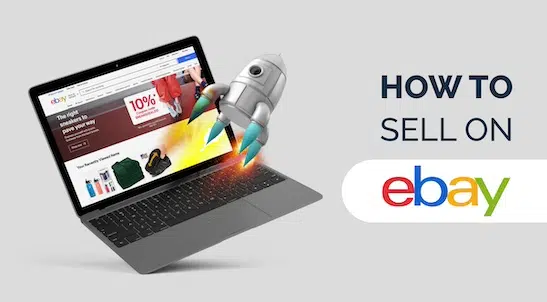Struggling to turn your eBay listings into profitable sales? In this guide, I will reveal how to optimize your eBay listings, manage shipping costs effectively, find profitable products, and build a strong feedback score to boost your sales.
All of this is based on my 9+ years of selling on eBay – so you know that I am going to be bringing the goods!
Lots of people sell on eBay, but the truth is, there are lots of eBay sellers that fail to generate a significant profit.
Why?
They simply don’t learn how to master the basics, like optimizing their listings, managing their shipping costs, finding great products to sell, and building their feedback score. A key part of optimization is getting your titles right. With ZIK’s eBay title builder, you can quickly generate keyword-rich titles based on real buyer searches, making it easier for your listings to rank higher and attract more clicks.
Before you list anything, use an eBay competitor research tool to see real demand, pricing, and sell-through so you avoid low-margin products from the start.
That’s why in this article, we’ll go over how to sell on eBay step-by-step, so that after reading – you will have a thorough, battle tested game plan to take your eBay Business to the next level!
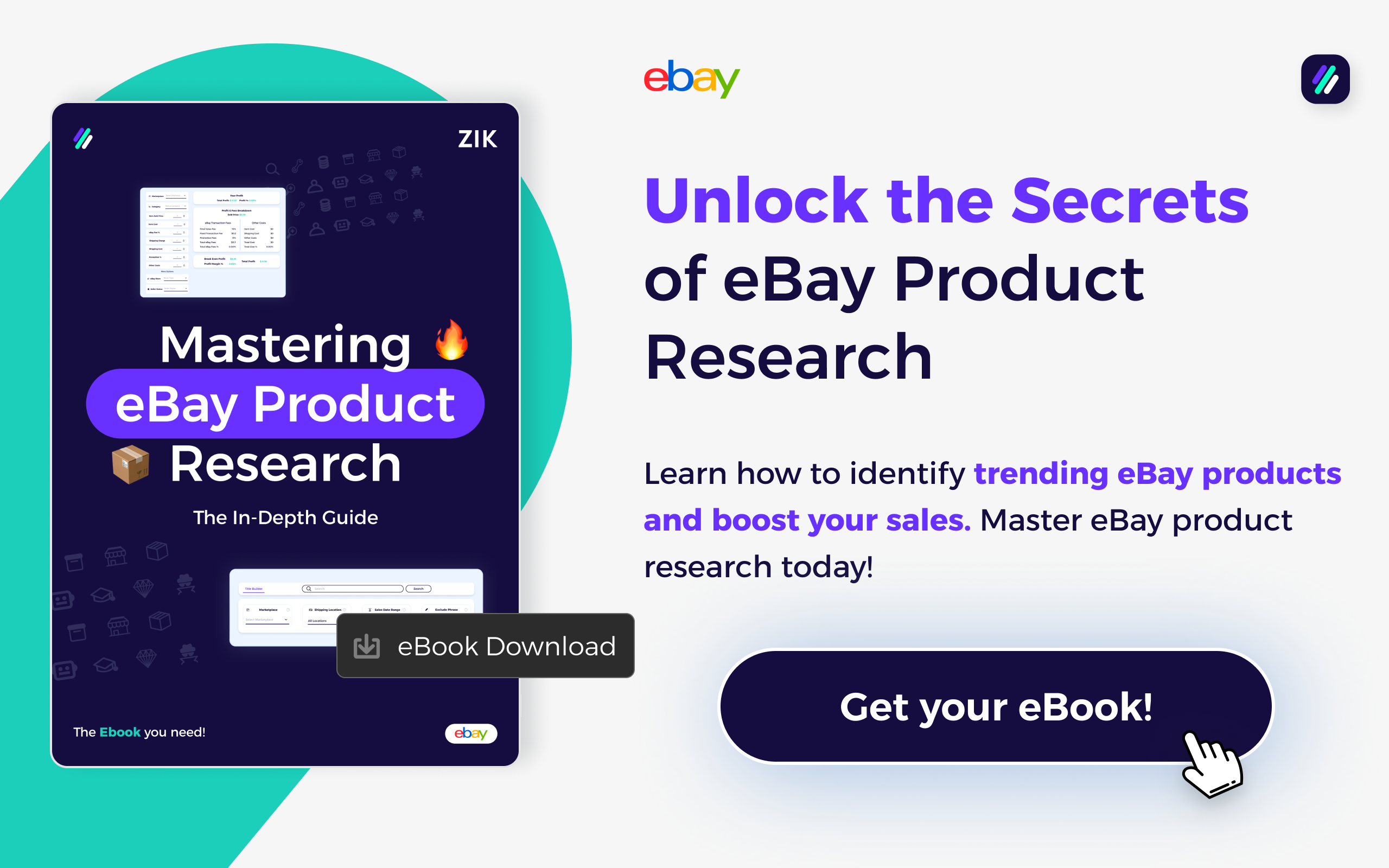
Key Takeaways
- ✔ To excel in eBay selling, focus on optimizing listings, managing shipping costs, finding great products, and building a solid feedback score.
- ✔ Understand eBay’s operational dynamics including auction vs fixed price listings, and align your selling strategies accordingly.
- ✔ Utilize tools like ZIK Analytics for effective product research and market understanding, crucial for eBay selling success.
Before You Get Started
Before diving into eBay selling, familiarize yourself with how eBay functions and the tools at your disposal. Understand the differences between auction and fixed price listings, and prepare to manage shipping costs efficiently.
Consider using ZIK Analytics for product research, offering a deeper insight into what sells well on eBay.
Selling on eBay for beginners Step-by-Step
Watch: Our Beginners guide to selling on eBay

Not only that, but we’ll also give you 10 eBay selling tips from expert sellers on eBay that both beginners and experts can benefit from.
Step 1. Understand how eBay works & how to sell on eBay
If you’re going to jump into the eBay ecosystem and start listing your products, it’s important that you have a good understanding of how the platform works.
Here are a few things you need to know before you start selling on eBay.
eBay Auction vs. Fixed Price Buy-It-Now listings
Back in 1995 when eBay first started, the only option for listing a product was auctions.
Now, eBay allows sellers to list products with a fixed price listing.
Auctions are becoming a thing of the past. This is because of the increased urgency of online purchases.
eBay buyers simply don’t want to wait 7 days for an auction to end before the product they want is shipped to them.
This is why eBay is moving towards the “Buy-It-Now” option, is offering money-back guarantees, and is encouraging sellers to offer free shipping and guaranteed delivery.
Auctions aren’t just a disadvantage to eBay – sellers also experience disadvantages when listing auction style items on the platform. Such as:
- Lack of Google indexing – Having your items indexed by Google is an important part of getting your product exposed to the right audience if you want to run your eBay store like any other eCommerce business. Unfortunately, auctions aren’t live long enough for Google to place them in their search results.
- Limited Visibility – Because auctions have a set start and end date, they may not reach enough people during the time they’re live on eBay. Potential buyers may miss the listing by looking for the product after your auction has ended.
- No Automation – Auctions have to be managed manually. Buy-It-Now type listings can be managed with eBay automation and analytics software.
If you simply want to get rid of a product quickly, an auction style listing might be your best bet. However, if you want to grow a thriving eCommerce business on eBay, Buy-It-Now listings are the way to go.
How buyers find products on eBay
If you want to sell on eBay, you need to understand how potential buyers will find your product.
On eBay, users find products in 2 primary ways:
- The feed
- eBay’s search function
eBay’s Feed
The Feed is eBay’s newly formatted homepage that provides recommendations for daily deals, trending items, and more.
People often browse these categories in search of new products they haven’t heard of before.
Here are just a few categories eBay shows on their homepage feed:
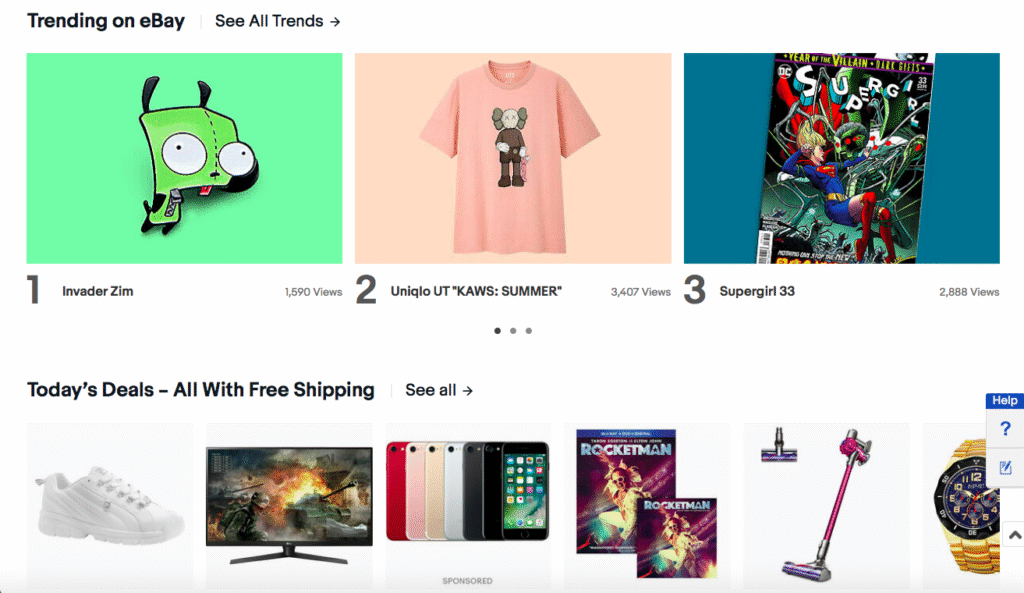
eBay’s search function
Most people, however, come to eBay in search of a very specific product. This is when they leverage the search function.
For example, if I type “electric guitar” into the search box, here’s what I see…
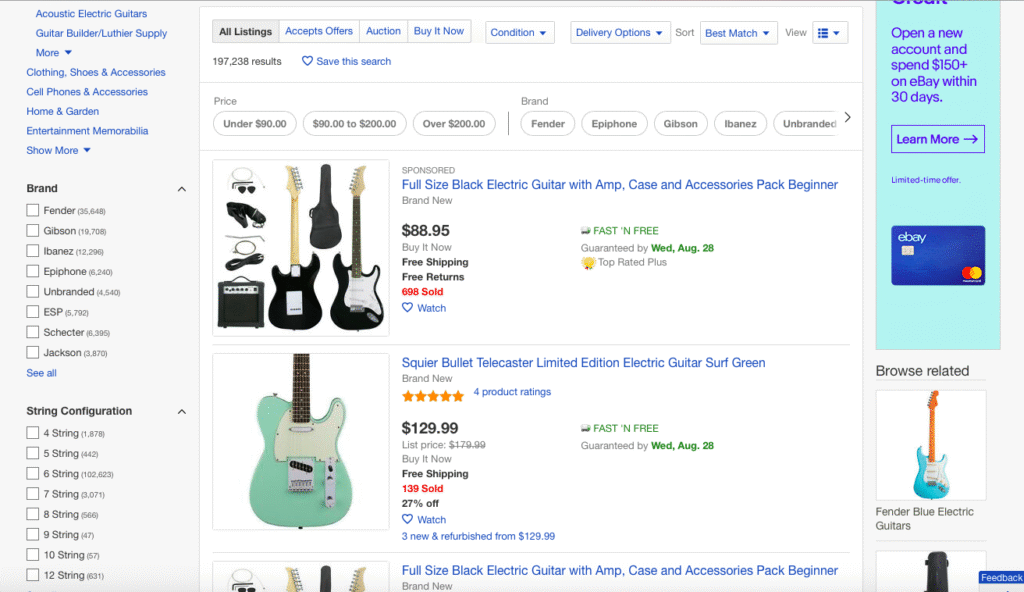
Notice that in the top result (after the sponsored one), the following are highlighted in the listing:
- Free shipping
- Guaranteed delivery date
- Good reviews
This is important to keep in mind when optimizing your listing, which we’ll get into later in this article.
eBay’s selling policies
Before you sell on eBay, it’s important to understand eBay’s rules for sellers. Failure to follow eBay’s policies could result in an account suspension.
A problem that can be detrimental for new sellers selling on eBay.
While I recommend that you read over eBay’s policies yourself, here are a few things to make sure you do to stay within their guidelines:
- Ship items quickly – On eBay, many buyers check the estimated delivery date of a product before making a purchase. If you miss this date, it results in a negative buyer experience.
- Upload your tracking details – Buyers are always eager to get the item they paid for. eBay knows this, and requires that you share tracking details with buyers to provide a good experience. You’re also protecting yourself in case the buyer opens a Money Back Guarantee request.
- Sell ethically – If you’re selling a used item, don’t mark it as new. This should be obvious, but there are sellers out there that try to unethically game the system.
- Resolve buyer conflicts quickly – If buyers are unhappy, this reflects poorly on eBay. Even if you think a buyer is being unreasonable, you should do whatever you can to resolve conflicts. You can always block a buyer from buying from you in the future.
- Don’t sell off of eBay – It’s against eBay’s terms to sell off of the platform. Make sure when you communicate with buyers, you do so only within eBay’s ecosystem.
- Don’t list banned items – Listing items that are banned from being sold on eBay is an easy way to get your account suspended. If you think your product may be at risk of being banned from being sold on eBay, check their restricted product list before you list your items.
Step 2. Create your eBay account
Creating an eBay account is pretty straightforward. I’ll walk you through the steps.
First, head over to eBay.com and click the “register” button at the top left of the screen.
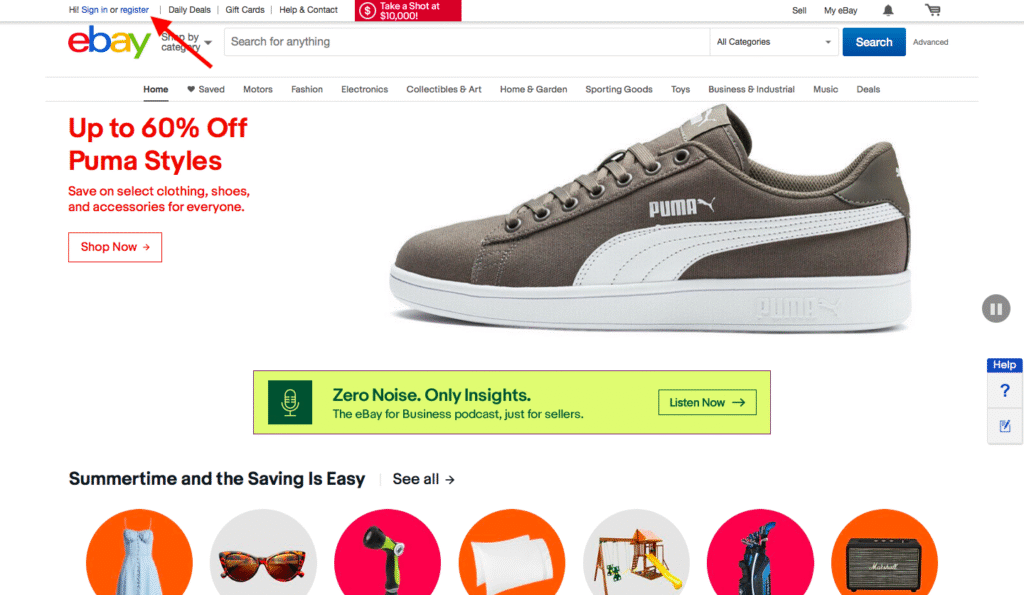
Next, you need to decide if you’re going to register as an individual eBay seller or as a business. You will need to set up an eBay business account for the latter.
If you want to register as an individual, simply fill in the first name, last name, email address, and password fields, or sign up with Facebook or Google.
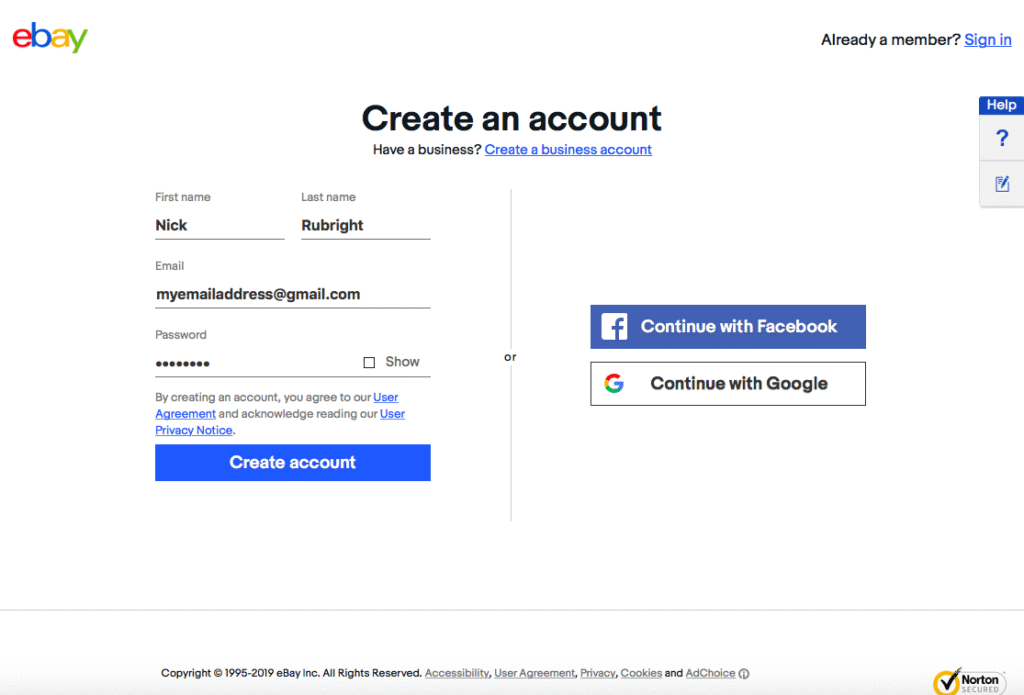
If you’d prefer to set up a business account, click the “create a business account” button at the top of the registration page.
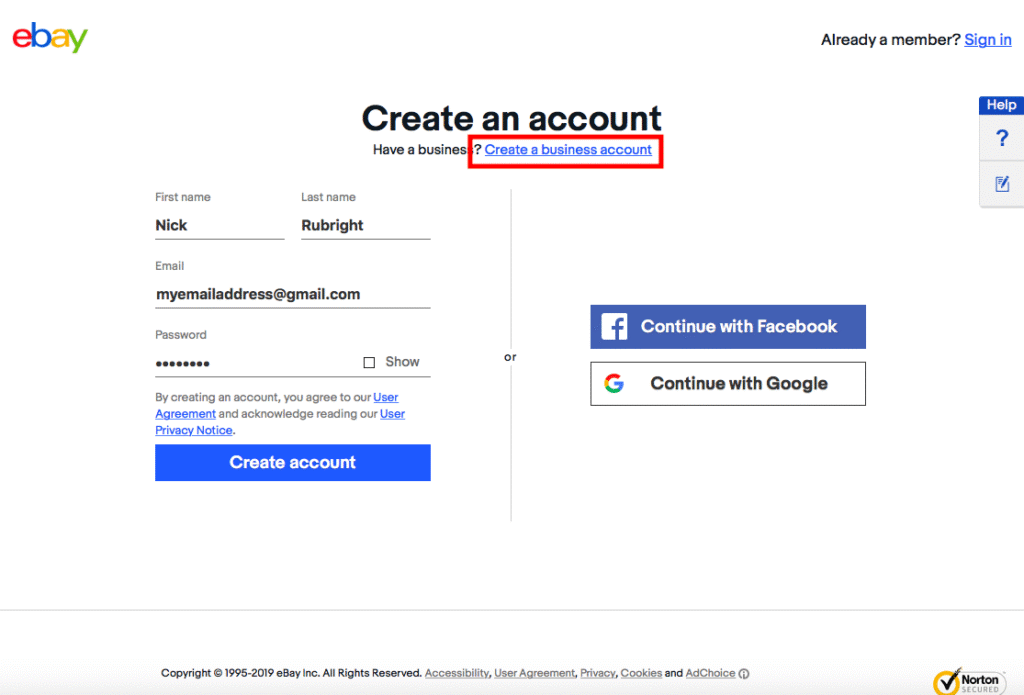
Finally, fill in the required info.
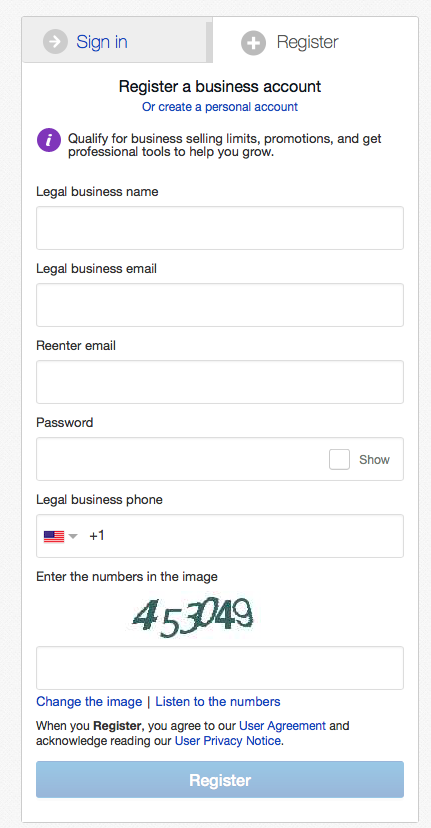
Step 3. Set up your payment method
After your eBay account is set up, you need to set up a payment method to pay eBay’s seller fees.
As of now, eBay managed payments has become the preferred way to accept payments on eBay, as PayPal has slowly been phased out.
To add a payment method to your eBay account, once you’re signed in, click “My eBay” on the top right corner of the home page.
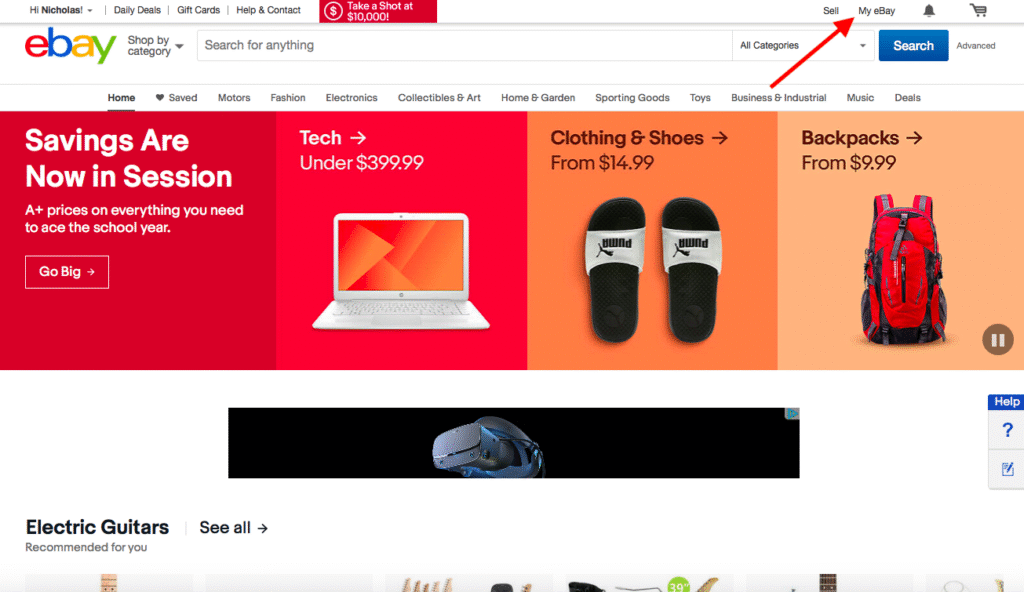
On the next screen, click the “account” button.

Finally, click “Personal Information” in the menu on the left, scroll down until you see the “Financial Information” section.
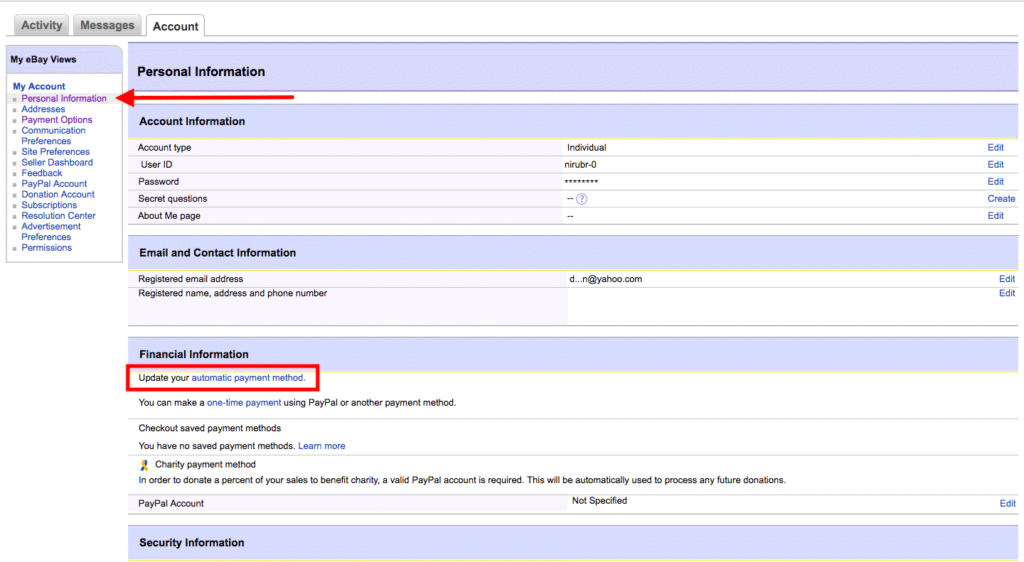
Click on the text that says “update your automatic payment method,” and follow the instructions.
This video will walk you through the specific steps to set up your payment method.
Step 4. Optimize your profile
You don’t need to have an elaborate profile if you’re selling one or two small items, but adding a profile picture, description, and choosing a good username can help increase your sales.
How to edit your profile on eBay
To edit your profile image and description, go to “My eBay,” click your username, and then click “edit profile.”
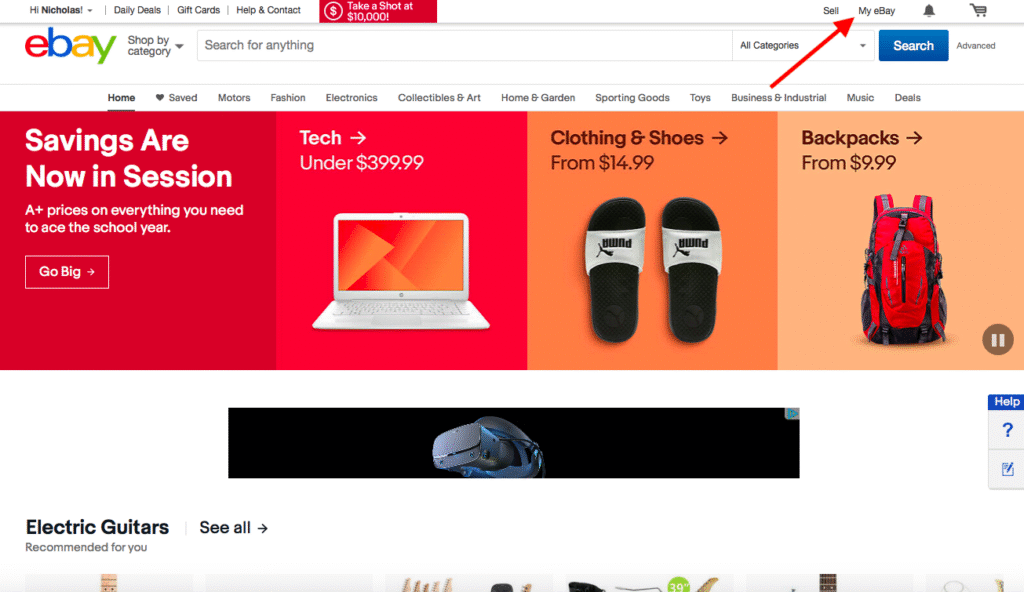
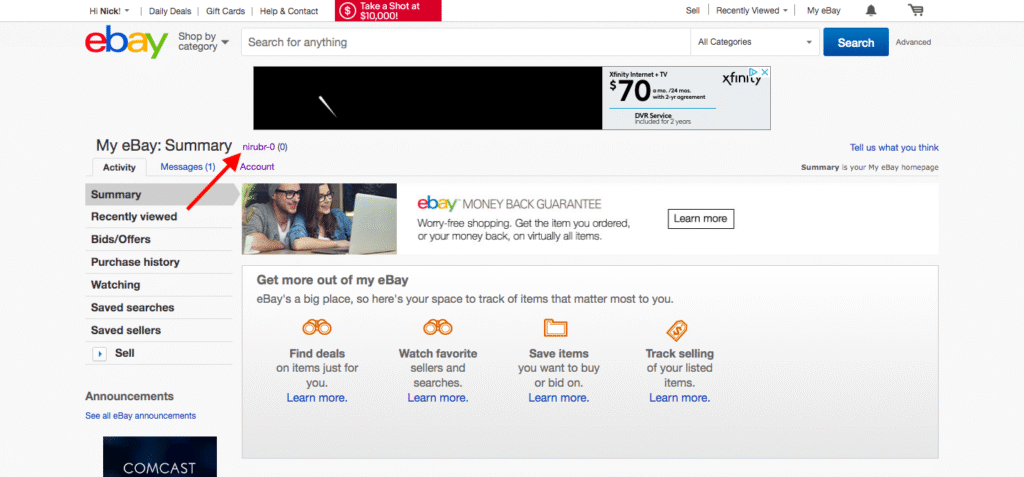
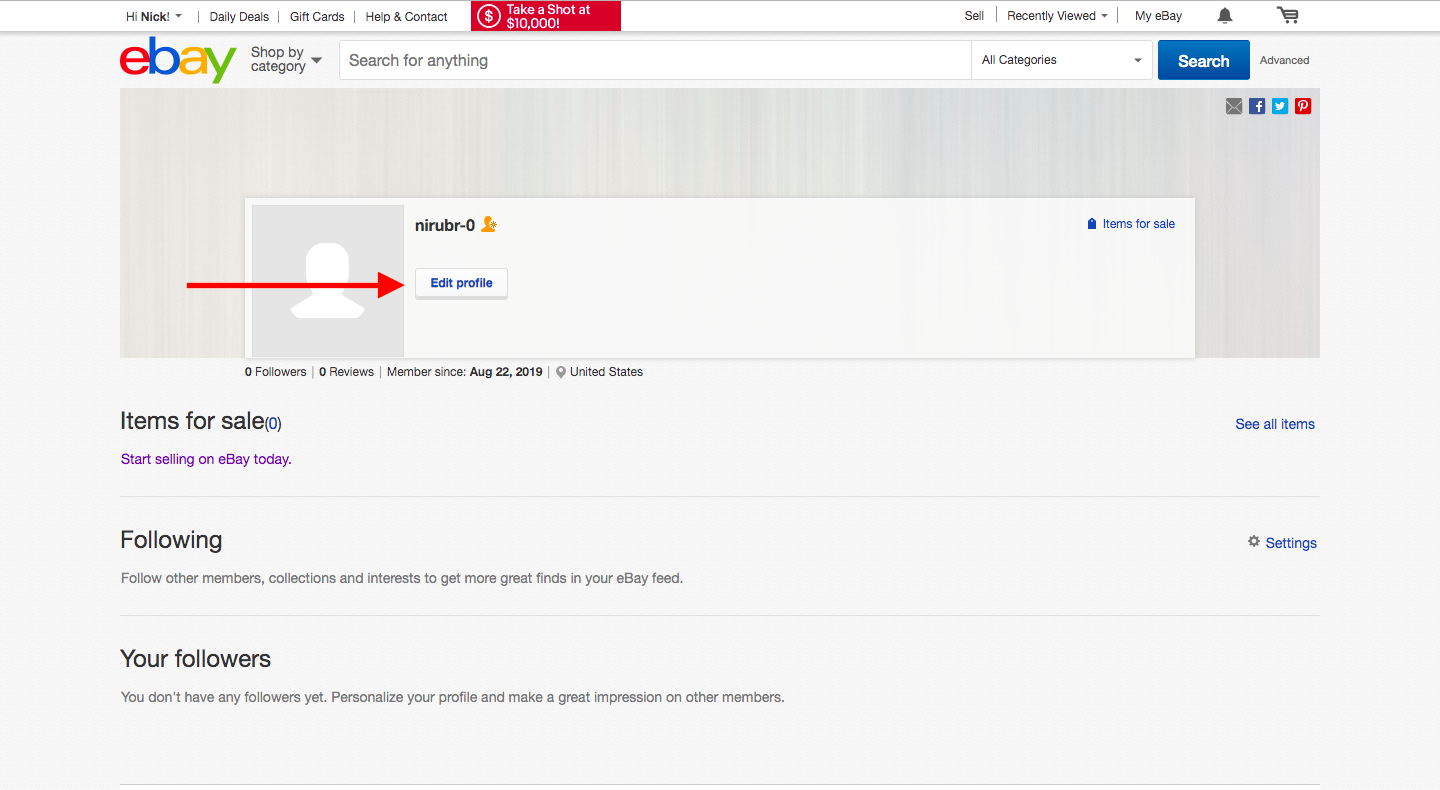
How to change your username when selling on eBay
Having an attractive username on eBay is important in generating sales. If you have a username like “isellstuff2219,” people are less likely to take you seriously.
If they don’t take you seriously, it becomes harder for them to trust you to deliver their purchase as promised.
To change your username, first go to My eBay.

Next, choose “Account.”

Finally, choose “Personal Information” in the menu on the left, and click “edit” next to your username.
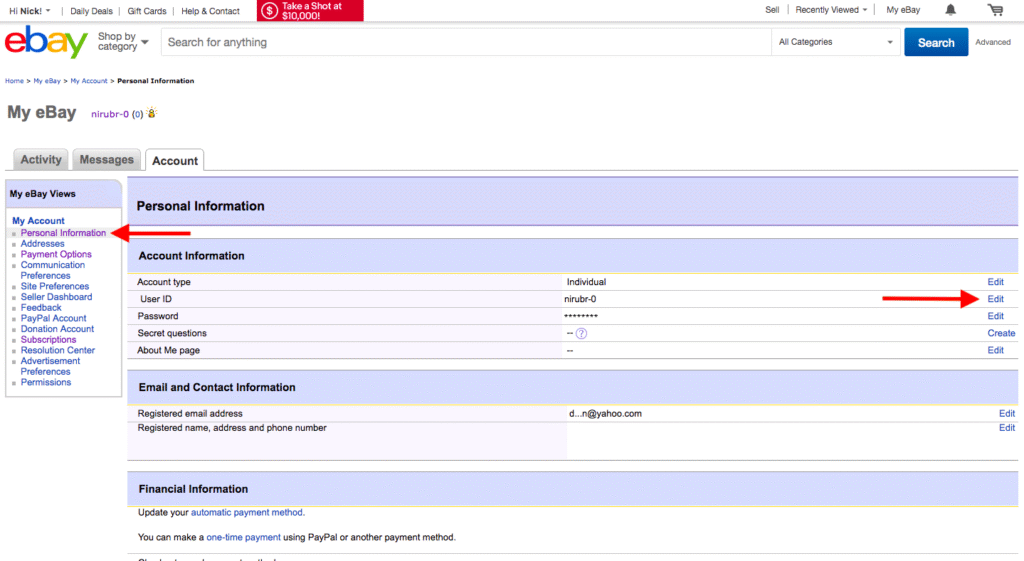
When choosing a username, keep the following in mind:
- eBay usernames must have at least 2 characters and can’t contain symbols like @, &, ‘, {}, or <>, and can’t have spaces or successive underscores.
- eBay usernames can’t begin with a period, hyphen, or underscore.
- You can’t use your website URL or email address as your username.
- You can’t use the word eBay in your username, nor the letter “e” followed by a series of numbers.
- Don’t use trademarked names.
- Offensive names can be blocked by eBay.
- There are lots of people on eBay, so it may take some time to find a username that isn’t taken.
- You can change your eBay username every 30 days, but doing so may make it hard for repeat customers to find your profile again, so do your best to choose the right name the first time around.
Step 5. Choose what to sell on eBay
Choosing what to sell on eBay is one of the harder parts of making money on the marketplace.
Here are a few things to keep in mind to make this decision effectively.
Know your market
eBay started out as a place for hobbyists and collectors, but has since expanded to a wide range of product categories.
Choose a category that you’re an expert in so you can effectively deliver value to your niche.
Knowing your market from the perspective of a buyer will help you understand how people are finding products and what they look for in a product description.
Check out whats trending by searching eBay completed listings
OR, save yourself HOURS by using ZIK Analytics to do your product research for you!

Know what you can’t sell
There’s a lot you can sell on eBay, but at the same time, there are many things you can’t.
The obvious ones are anything illegal or hazardous materials, but take time to review eBay’s restricted item list to be certain you’re allowed to sell the products you intend to.
You can also check out our guide to avoid VeRO items on eBay.
Start small and manage your growth
Too many businesses fail because they’ve grown too fast, and running an eBay store is no different. This, among other reasons, is why eBay places selling limits on new sellers – typically at around 5 items per month.
When you’re just starting out, it’s important to start small so you can take steps to manage your growth effectively and efficiently. Take your time to get a feel of how eBay works and what sells well on the platform.
It might be worth experimenting before you decide if this is for you. Sell some items around the house, or pick a few things up at the clearance section in your local retail store to test out on your eBay store.
Testing the market before loading up on inventory is very important. You don’t yet know if you’ll be able to sell your items at a high enough price to make a profit.
However, once you sell a few items on eBay, you’ll get a feel for what users are looking for and can then scale up your efforts.
Find what’s hot
If you want to list products on eBay that are going to sell, you need to know what’s hot.
What I’m about to show you is a fool-proof strategy for finding hot products on eBay.
First, you’ll need to choose a category that you have some familiarity with. So if you’re into electronics, this would be a good place to start.
To do this, click “Shop by Category” at the top of the page, and choose your desired category. If you don’t see yours in the menu that pops up, select “All Categories” at the bottom right of the menu.
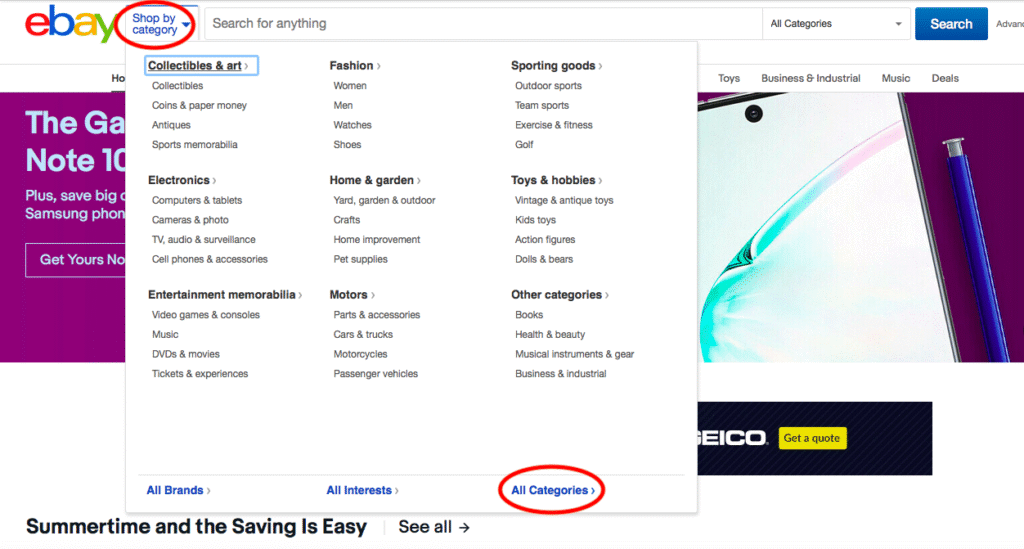
You may need to click into a subcategory depending on which category you choose.
Once you’ve found your category, you’ll want to filter your results to show only “Buy It Now” and “New” products. This will remove items that are being sold as one-time buys, like auction items.
We’ll also want to only show products that offer free shipping. This is a common practice among the best eBay sellers.
You can do this using the menu on the left. You may need to scroll down a bit to find these filter options.
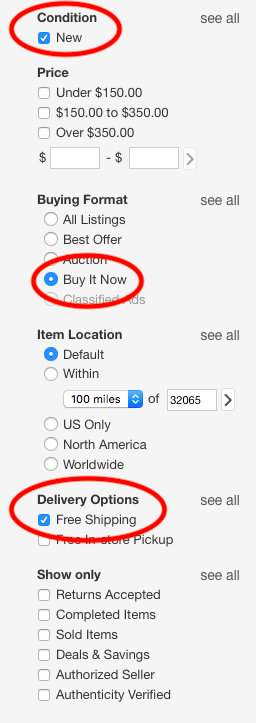
Finally, you’ll want to choose a product.
If possible, anything over $10. Products under $10 don’t have much margin and often aren’t very profitable after eBay takes their 10% and the 3% Managed Payment account fees. Use our eBay fee calculator to get exact numbers for your product.
Choose a product that’s selling well. Anything that sells at least 10 items within a 30 day period is considered good.
To check these metrics, find a product with a high “sold” count – like this one:

To see the selling frequency of the product, click the listing, then click the “sold” button on the listing page.
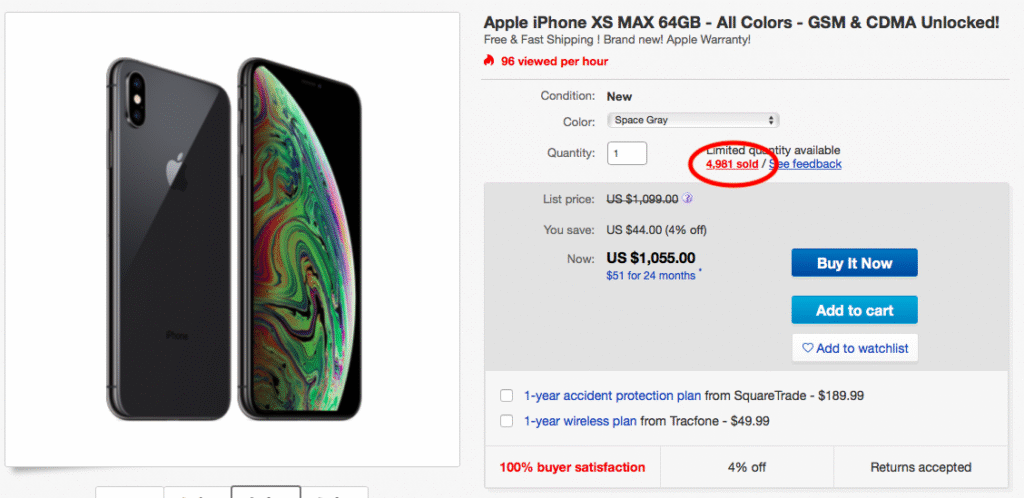
Clicking that will give you a look into the purchase history of the product, like this:
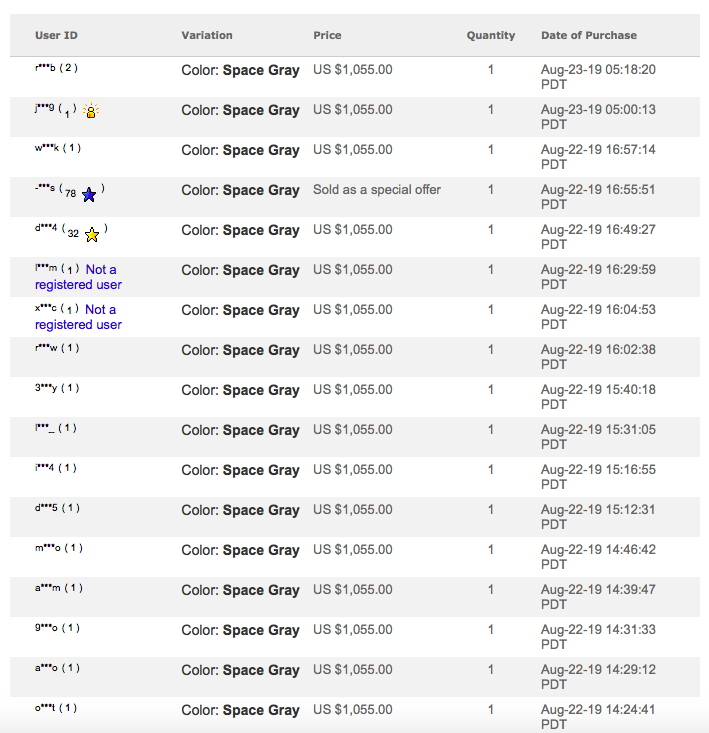
As you can see, there’s plenty of demand for the iPhone on eBay.
It’s also important to consider the weight of the product you’re going to sell. Heavier items cost more to ship, which can significantly cut into your margins.
If this sounds like a lot of work, that’s because it is. Scaling this stuff can be difficult and time-consuming, which is why at ZIK Analytics, we’ve built some eBay product research tools to help automate and scale the eBay selling process.

Choose how you’ll source your products
Determining how you source your products is an important element of building your eBay business.
Here are some ways you can source products to sell on eBay.
- Sell your own product – If you already have a product that you made to sell on eBay, you’ll need to operate your business like any other eCommerce business. Consider how you’ll handle things like inventory, shipping, and even marketing to increase awareness of your product on and off of eBay.
- Dropshipping suppliers – Dropshipping is a business model that many sellers use where the seller never touches the product. Basically, you list a product on eBay, and as soon as it sells, you make a purchase from your supplier, who then ships the product straight to the customer. Sellers on eBay frequently dropship from dropshipping suppliers like ChinaBrands, Doba, and SaleHoo.
- Retail arbitrage – Retail arbitrage is a kind of dropshipping where you leverage the inventory of another eCommerce store to effectively make them your supplier for your eBay stores. An example of this would be the business model of dropshipping from Amazon to eBay, or from Walmart. Dropshippers that use this business model list products on eBay, then as soon as the product is sold, they place an order on an online store like Amazon, but put the buyer’s address in.The idea here is to find products that are selling online on Amazon for a lower average price than what they’re being sold on eBay for. So if a guitar, for example, is being sold on eBay for $200, but is being sold on Amazon for $150, you can make $50 in profit by listing the item on eBay for $200 and fulfilling the order with the Amazon product. This business model works well when automated with software like SaleFreaks or DSM Tool.
- Clearance, garage sale, and thrift shop items – If you’re good at spotting deals at garage sales or thrift stores, and intend on selling on eBay at a smaller scale, this can be an effective way to build a profitable side business!
- Source items with gift cards that you purchase at a discount – This technique can be paired with any of the above. Basically, you buy discounted gift cards from websites like giftcardgranny.com or cardpool.com, then use these gift cards to purchase inventory that you then sell at full price on eBay. If you can buy a $50 gift card for $40, you can then purchase and sell a $50 item on eBay and profit $10, for example.
Step 6. Create and optimize your listing when learning how to sell on eBay
Now that you’ve chosen what you’re going to sell on eBay, the next step is to create and optimize your listing to give yourself the best chance at showing up in the search results.
Let’s walk through how to do that.
First, login to eBay, go to the home page, and click “sell.”
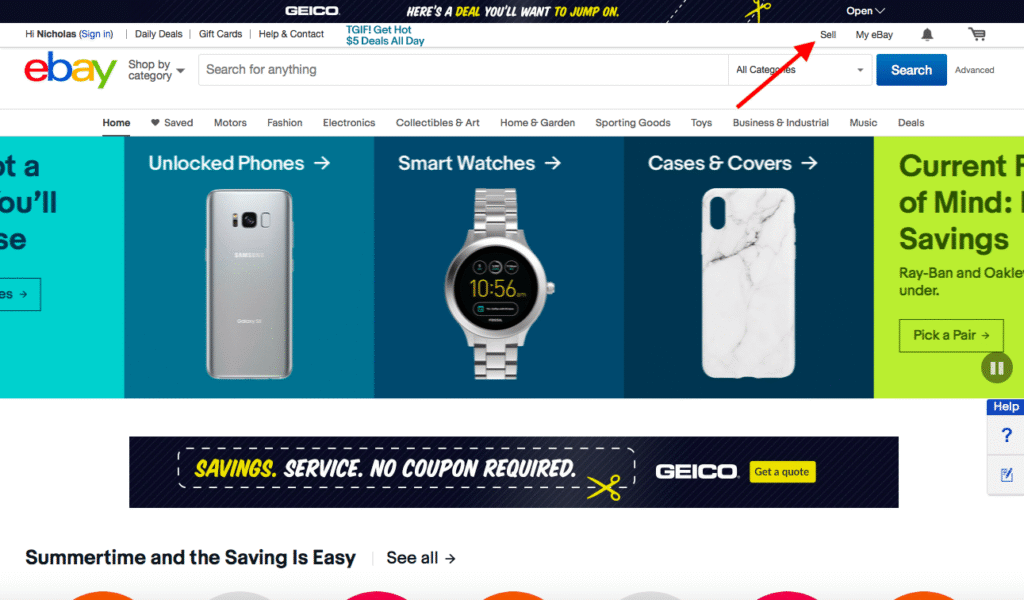
Next, type the product you’re trying to sell into the box. As you type, eBay will spit out recommendations from you to select from.
If you don’t choose any of the selections, eBay will show you a list of categories related to your entry, like this:
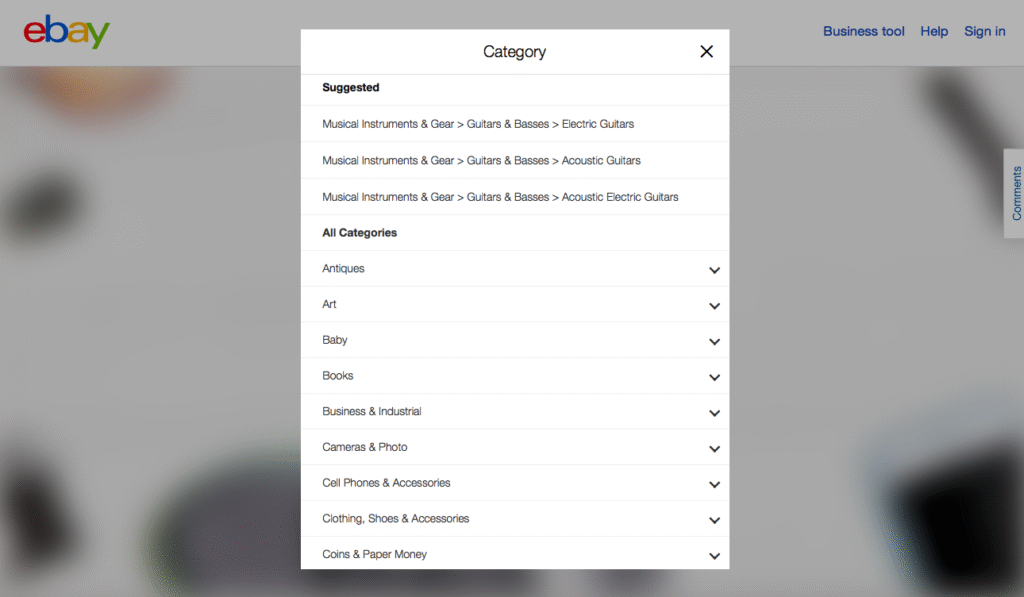
It’s very important that you choose a category that actually represents your product. Don’t choose an unrelated category in an attempt to get your product in front of more people.
These views won’t lead to sales. You want a targeted, relevant audience to see your product.
After you complete this step, you should be on the page where you give eBay the details of your listing. Let’s go over these one at a time.
6.1. Optimize your title with relevant keywords
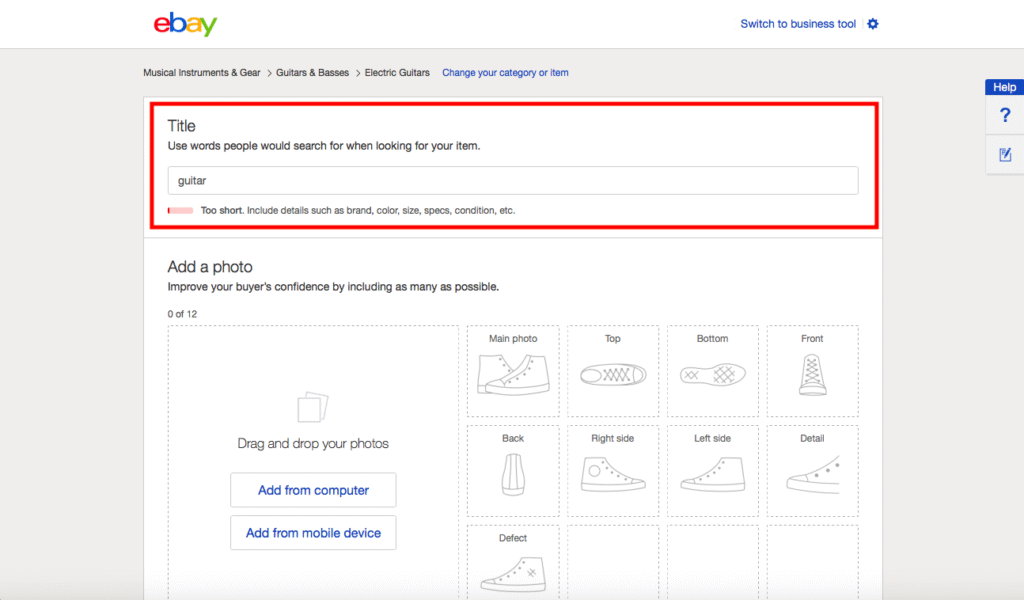
The best way to write your title is to write with the human in mind – not the search engine.
If your title contains relevant information that describes what users are looking for, it’s more likely to be clicked on, which means your listing will get more views.
When writing your title, it’s best to include information such as the brand, model, color, size, specs, condition, or anything else that may apply to your listing. Be specific.
Remember – the purpose of your title is to attract a targeted audience. What matters on eBay isn’t how many people see your listing, but the conversion rate.
A conversion rate is the number of sales versus the number of visits to your listing.
For example, if you get 100 listing views and make 1 sale, that’s a 1% conversion rate.
If you get 2 sales from those 100 views, that’s a 2% conversion rate.
If you write a specific title, you’ll get your product in front of an audience that’s looking for what you’re selling, which will result in higher conversion rates.
This doesn’t mean you should consider things like monthly searches, keyword competitiveness, and other factors.
It doesn’t make sense to go after keywords like “iPhone” that tons of other sellers are going after.
eBay analytics tools like the Zik Analytics eBay title builder can help you make better keyword decisions for your titles.
6.2. Have high-quality photos
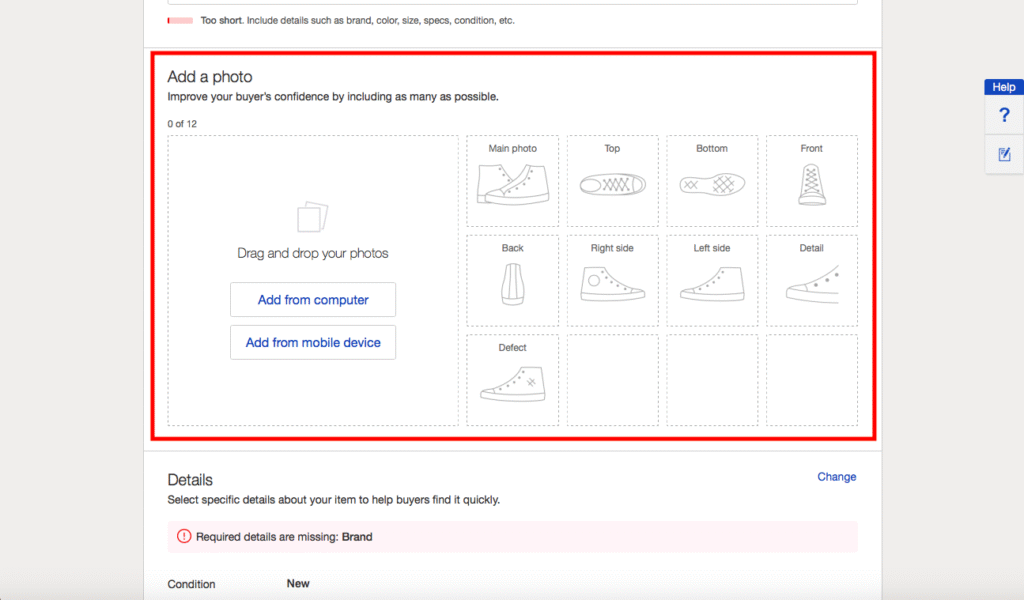
One of the most common tips we got from expert sellers for our 10 tips section at the end of this article was to include high-quality photos for your listing.
Let’s face it – humans are visual. If your product is listed next to a competing item with a better photo, you’ll lose clicks (and sales) to that competitor.
On top of that, it’s important to include as many descriptive photos as are necessary to visually explain the condition of the product.
If you’re selling a used product and it has some paint chips, for example, make this clear in the photos.
You can also include helpful charts and graphics when necessary if your product requires it. Sizing charts for clothing are a good example of this.
Put yourself in the buyer’s shoes and make an effort to understand what elements of your product need a visual explanation.
6.3. Fill in the item details
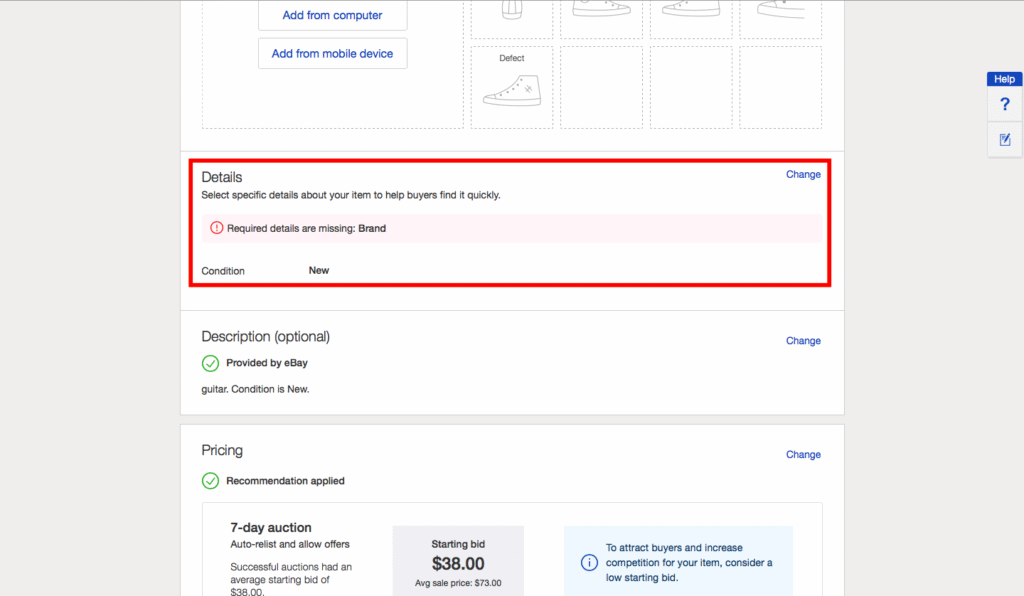
The item details are part of what eBay uses to place your item in filtered search results.
When users search for products on eBay, there’s a menu on the left that contains filters specific to a product type.
For example, here are what some of the filters look like for iPhones:
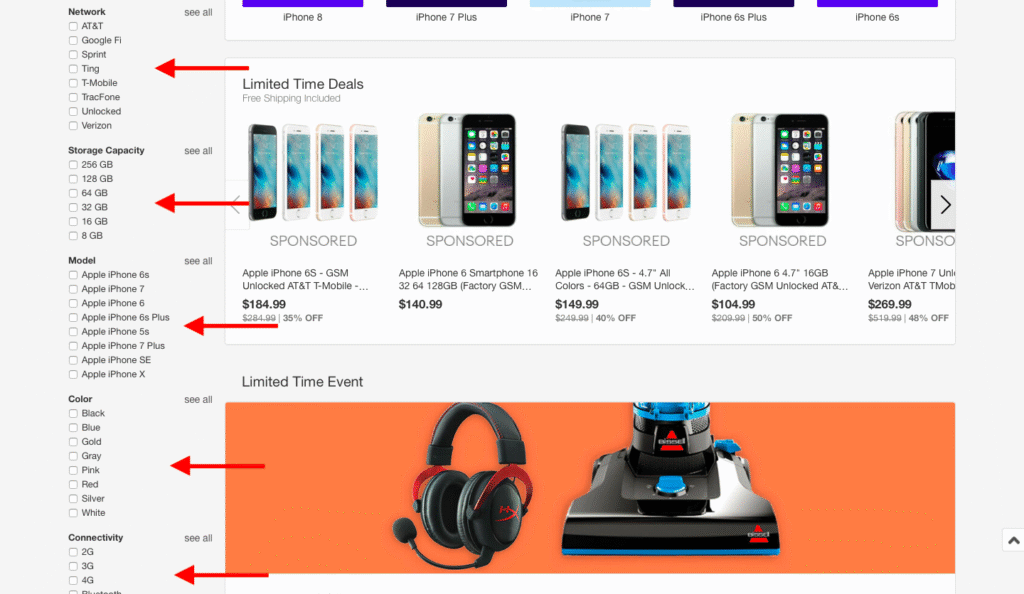
To add these details for your product, simply click the “Change” button in the “Details” section when creating your listing, and fill in as many of them as possible.
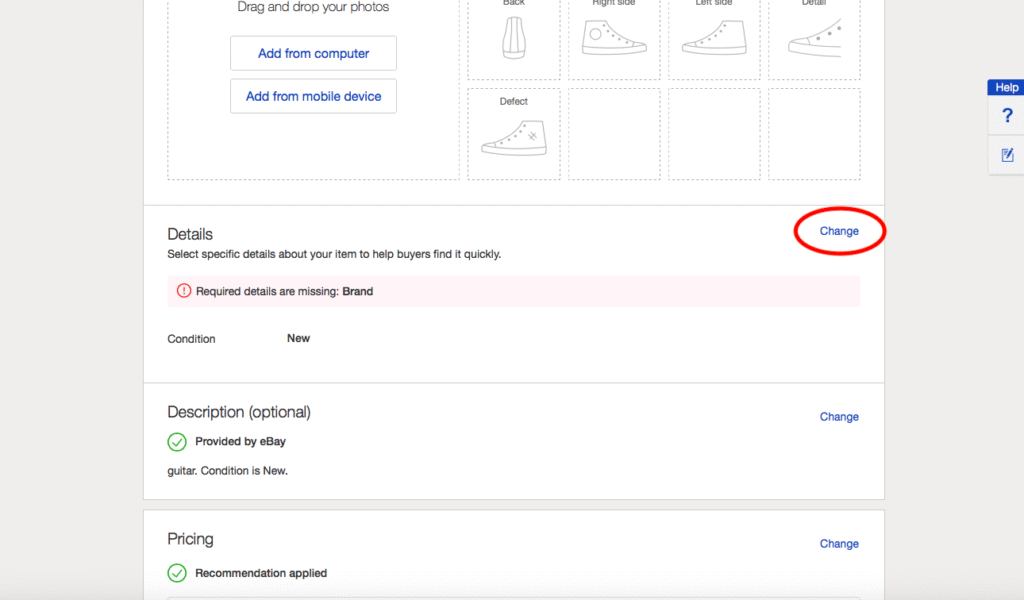
6.4. Write a compelling listing description
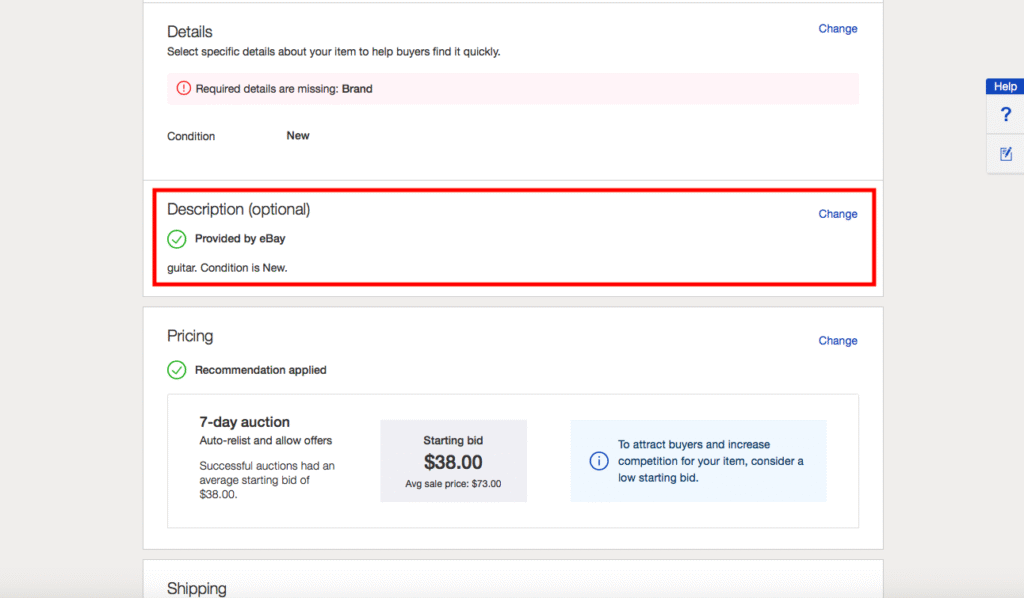
Your listing description is your main opportunity to convince customers to purchase your product, so it’s important to make it compelling.
Here’s what eBay has to say about the description: “Include at least 200 words of visible copy in your listing description, with the most important keyword phrases mentioned at the beginning and end.
Remember to employ other content best practices, such as the frequent use of keywords where relevant and formatting (e.g., bolding, using font size on important titles and keywords).”
To that, I’d add a few things:
- Include any necessary product-specific information – If you’re selling a used product, this might be a good place to reveal any damages the product has, so you don’t end up with returns. Additionally, if you’re selling something that requires additional usage information, such as the fact that an electric guitar requires an amp, write that in the description as well.
- Make it short and easy to skim – People don’t have time to read entire paragraphs of information. Write your product information in a way that makes it easy for visitors to dissect in a few seconds. Use bullet points wherever possible.
- Write to sell – This is an art in and of itself. Learning the art of writing product descriptions that sell can boost your conversion rates significantly.
- Cater to Cassini – Cassini is eBay’s search engine, and it looks through your product description when deciding where to place your product in search results. According to eBay, it’s best practice to include your target keyword near the beginning and end of your description.
eBay Seller Tip
Do not forget to FULLY flesh out your item specifics
6.5. Price your product
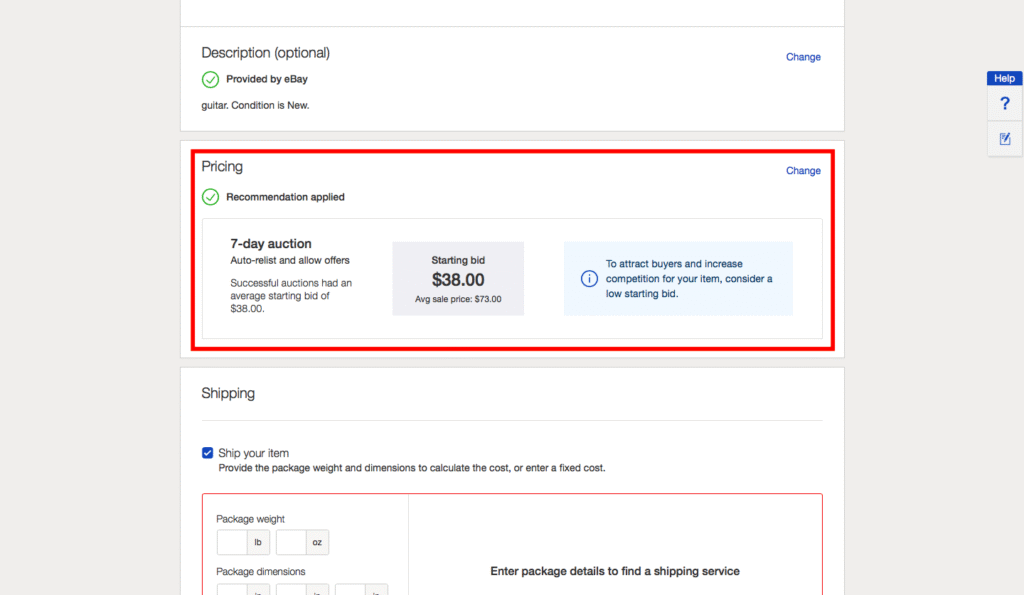
When pricing your product on eBay, you want to consider 2 things:
- The price of competing products.
- Your profit margins.
The hard truth is, eBay customers will shop by price. If you want to beat your competitors, you need to have a lower price than they do.
That said, it’s also important to protect your margins and account for your final value fees. You need to account for all of your eBay selling fees, such as your eBay insertion fees and managed payment fees.
Once these are taken into account, you need to come out positive.
That’s why it is important to list your items in a way that allows you to charge more on eBay!
When pricing your eBay listing, eBay will give you the option between a “Buy-It-Now”, fixed price listing, and an auction-style listing.
Auction-based pricing
Auction-based pricing is great for when you have a product you want to get rid of quickly and care less about the profitability of the sale.
Auctions last for 1-10 days, and can even result in a higher price for your item than you may have expected.
If you do want to profit from auction-style listings, you can set a reserve price, which allows you to set a low starting price for your listing, but eBay charges an additional final fee for this since it reduces the chances of a sale occurring.
It this into account as setting a starting price will impact the final value fee.
Auction-style pricing is best when you have an item that people are likely to fight over, like a rare collectible. It may also be fitting when you don’t really know what to price something at.
Buy-It-Now items
Buy-It-Now items are fixed-price items. Fixed price listings allow for more immediate transactions, and are better if you’re trying to build an e-commerce brand off of eBay.
When using fixed price selling, you also open yourself up to using numerous eBay automation tools to run your business that aren’t always available on auction format listings.
Using the fixed price option also gives you a bit more visibility on your final value fee, as it isn’t variable, as it is with auction-style listings.
This type of clarity on your selling fees is key for any eBay seller, as it allows you to model your profits more accurately.
6.6 Edit your shipping preferences
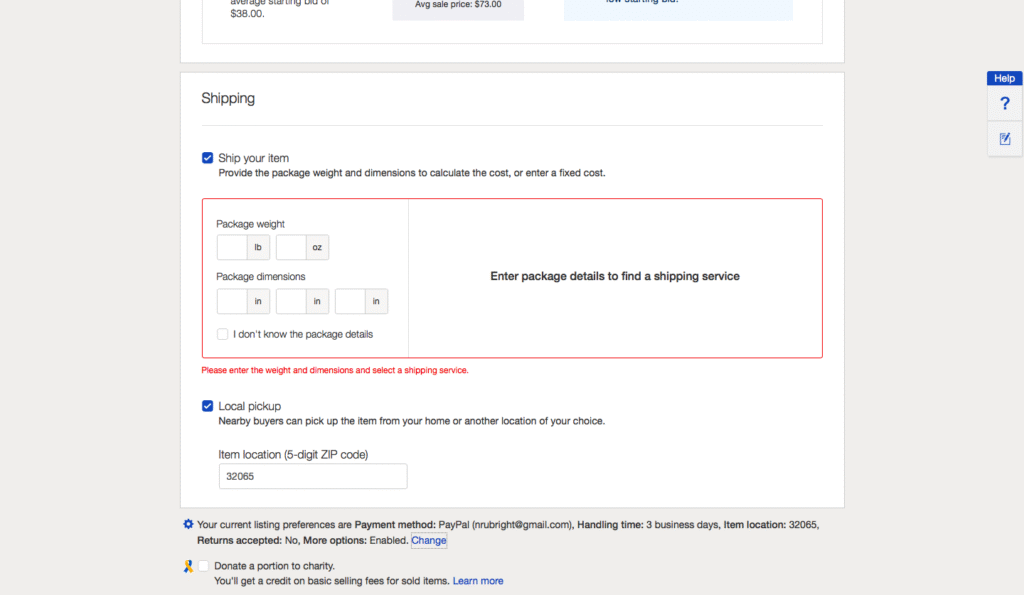
eBay allows you to see what it will cost to ship your product by entering your package weight and dimensions.
Many buyers will use the filters on eBay to only show products offering free shipping. Even if you need to build the shipping cost into the price of the product, do what you can to offer this.
To manage your shipping costs, you can also offer various shipping options and an option for local pickup.
With local pickups, you can accept payment via check, money order, cash, PayPal account, or credit card. However, be careful when accepting check or money order payments.
If a check or money order doesn’t clear after the buyer has picked up the item, there’s little you can do to resolve this.
6.7 Offer a good return policy
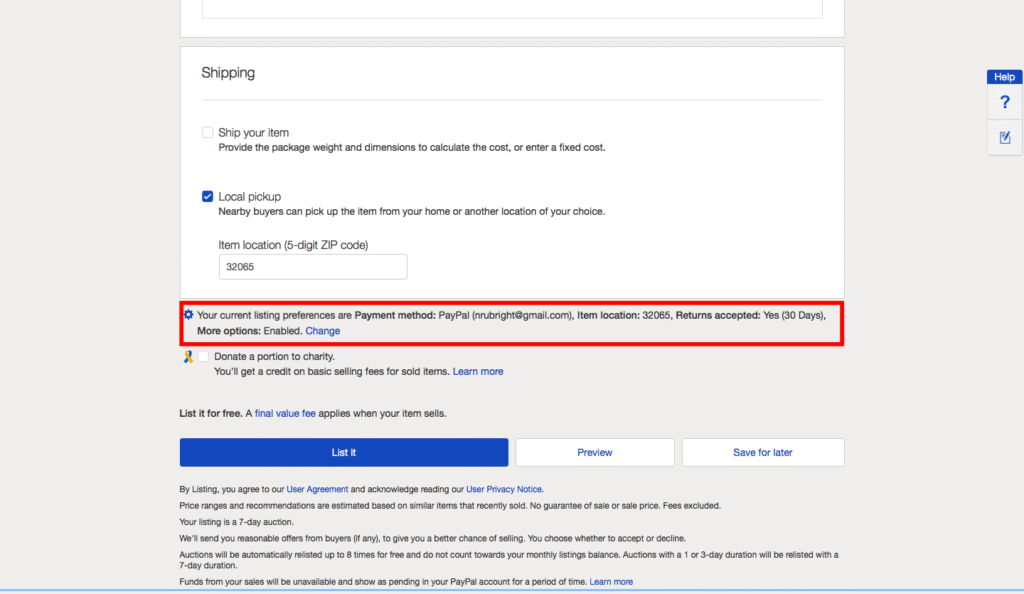
For every listing, eBay requires that you have a return policy in place.
The return policy options for sellers are as follows:
- No returns
- 30 days, paid by the buyer
- 30-day free returns
- 60 days, paid by the buyer
- 60-day free returns
It’s important to note that to become a Top Rated seller on eBay, you must offer at least a 30 day return policy with your listings.
If you are selling things on eBay in any of these categories, you’ll also have the option to offer a 14 day return period:
- Collectibles & Art
- Camera & Photo
- Medical, Mobility & Disability Equipment
If you want to know more about this, check out our guide about how to choose a return policy on eBay.
Step 7. Complete the transaction
After you’ve sold an item on eBay, it’s important that you quickly take care of shipping. Make sure you confirm the shipping details prior to booking the shipping labels.
Fast, safe shipping of your products is a great way to get positive feedback, which can further increase your attractiveness to buyers who come across your listings.
eBay has created this guide to help sellers get a hang of shipping best practices, but essentially, it comes down to speed, quality of packaging, shipping options, shipping service, and making sure you upload your tracking numbers provided on your shipping label so buyers can track their shipment.
You can also check out our comprehensive guide to shipping on eBay here
After the product is delivered, it’s in your best interest to follow up with them to make sure things went well. If they’re happy, ask them to leave a review.
What to Avoid Doing
- ✘ Avoid neglecting eBay’s selling policies – not adhering to them can lead to account suspension.
- ✘ Don’t overlook the importance of fast shipping and accurate tracking details – these factors significantly impact buyer experience and feedback.
- ✘ Avoid unethical selling practices, such as misrepresenting product conditions. Honesty is key to building trust on eBay.
- ✘ Don’t ignore buyer conflicts; resolving issues promptly can prevent negative feedback and enhance your reputation.
- ✘ Avoid selling banned or prohibited items on eBay to prevent account suspension.
How to Prevent Potential Issues
- ✔ Regularly review eBay’s selling policies to stay updated and compliant.
- ✔ Ensure timely shipping and accurate tracking to maintain positive buyer experiences.
- ✔ Maintain honest and transparent product descriptions to build and preserve trust with your buyers.
- ✔ Proactively address and resolve buyer conflicts to maintain a positive seller reputation.
- ✔ Stay informed about eBay’s list of banned items and regularly check your inventory against it.
Ready to Start Selling on eBay?
Finding the right products is the foundation of a profitable eBay business. The eBay product research tool helps you uncover high-demand, low-competition items based on real-time sales data. Instead of guessing what to sell, use clear insights to make smart listing decisions that attract buyers. Whether you’re just starting out or scaling up, ZIK gives you a winning edge. Start your eBay journey strong—try the ZIK Product Research Tool now.
Selling On eBay: Frequently Asked Questions
Here are some frequently asked questions about how to sell on eBay
What are the costs on selling on eBay?
Ignoring the costs associated with eBay is easy to do. Many sellers continue to list items without evaluating the profitability of their eBay sales. The total cost to sell an item on eBay will depend on a few factors, such as how you list your product and how much you want to sell it for. The cost to sell on eBay isn’t exactly a straightforward answer, so I’d recommend using this eBay Calculator to get a look at the costs involved with selling your products.
Is it better to sell on Amazon or eBay?
It depends on your goals. eBay suits sellers who want to build a brand, sell unique or flipped items, enjoy higher margins, and get instant payouts. Amazon fits those focused on quick sales, proven products, lower prices, and who don’t mind smaller margins or delayed payments.
Is it still possible to make a profit?
Yes. Many sellers still profit on eBay by choosing in-demand, low-competition products, sourcing cheaply, and optimizing listings for search. Control fees, shipping, and returns, and price for margin after all costs. Use data tools, test small, reinvest into winners, and maintain top-rated performance to boost visibility and conversions over time.
How do I sell on eBay for the first time?
To sell on eBay for the first time, create a seller account, link a payment method, and set up preferences. Then list an item by adding photos, a descriptive title, item specifics, price, and shipping details. Once sold, ship promptly and maintain good communication.
What is the downside of selling on eBay?
The downside of selling on eBay includes paying fees on sales, dealing with high competition, and facing strict policies that may lead to account restrictions. Sellers also handle returns, disputes, and shipping responsibilities, which can cut into profits and require careful management to succeed.
How much does it cost to be a seller on eBay?
The cost to sell on eBay varies based on listing type, category, and optional features. Sellers typically pay an insertion fee when listing (often free for many listings up to a limit) and a final value fee once the item sells, which is a percentage of the total sale amount. Additional costs may include promoted listing fees, currency conversion, or international fees if selling overseas.
How much does eBay take from a $5 sale?
If you sell an item for $5 on eBay, here’s how the fees might work: eBay charges a final value fee (percentage of total sale plus shipping/tax) plus a fixed order fee — $0.30 for orders of $10 or under. So for a $5 sale, expect to pay ~$0.30 + the applicable percentage (often ~13–14%) of the $5, which means your fees will be around $0.95–$1.05, totaling about 20–25%.
Do you need PayPal [Updated in 2025]?
No, eBay no longer uses PayPal for payments. eBay Managed Payments with Payoneer is now the default. Alternatives include Skrill, accepting credit or debit cards via a merchant account, or in-person payment on pickup. Sellers must still follow eBay’s accepted payment methods policy.
Selling on eBay?
If you are selling on eBay, you might want to check out our related posts below.













